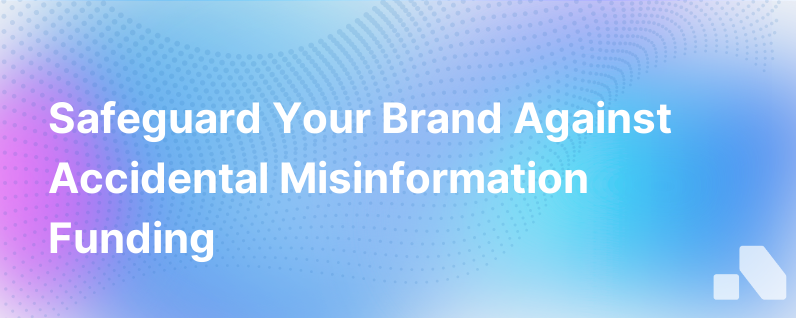Stop Your Brand From Accidentally Funding Misinformation
Published on August 6, 2023 by Sawyer Middeleer
In the digital age, misinformation proliferates at an unprecedented scale and speed. Brands that invest heavily in online advertising often find their advertisements placed alongside unverified content or on platforms that, knowingly or unknowingly, enable the spread of false information. This not only tarnishes the brand's reputation but also inadvertently funds sources contributing to the misinformation maelstrom. How can your brand adopt measures to avoid such unintended consequences and maintain integrity within its advertising ecosystem? Let's dive deep into strategies that can fortify your brand against the inadvertent support of misinformation.
Understand the Ecosystem of Online Advertising
Modern online advertising is largely automated. Programmatic advertising, which uses algorithms and machine learning to buy and place ads in real-time, dominates the landscape. It allows brands to reach a broad audience efficiently but also poses a risk: the lack of visibility into where ads get placed can lead to brands inadvertently supporting misinformation.
Define Brand Safety and Brand Suitability
Brand safety refers to measures taken to prevent a brand's advertisement from appearing in a context that doesn’t align with its values or could damage its reputation. Brand suitability goes a step further, ensuring the ad's environment (be it the type of content or the platform's integrity) aligns with the brand’s image and goals. It's about finding the right fit, not just avoiding the wrong places.
Develop a Comprehensive Ad Placement Strategy
Strategically, companies should understand exactly where their ads could potentially be shown and work closely with advertising partners to set clear parameters. Here are key components to consider:
-
Clear Standards and Criteria: Establish internal standards for what constitutes acceptable and unacceptable content for ad placements. Be as specific as possible.
-
Granular Targeting Options: Work with advertising platforms that provide granular targeting options. Understand the types of content and sites that align with your brand and select those for your ad placements.
-
Third-Party Verification: Use third-party verification services to confirm that your ad placements align with your brand safety criteria.
-
Blacklists and Whitelists: Maintain updated lists of sites that your brand will categorically never advertise on (blacklists), and a list of approved sites that match your brand's values (whitelists).
-
Regular Reviews and Updates: The web’s landscape is perpetually shifting. Regularly review and update your placement strategies to keep pace with changing content and site dynamics.
Partnerships and Transparency
Collaborate with agencies and ad networks that make transparency a priority, allowing brands to see where their ads will appear and ensuring that the standards for content are rigorously upheld.
- Selecting the Right Partners: Partner with ad tech providers and media agencies that are committed to transparency and are willing to work within your brand safety guidelines.
- Holding Partners Accountable: Create a framework of accountability for partners. Instruct them to conduct audits and provide reports that ensure adherence to safety standards.
Continuous Investment in Innovative Solutions
The fight against misinformation demands continual investment. Emerging technologies, like AI-driven content analysis, can better predict and prevent ads from appearing next to harmful content.
- Invest in AI Monitoring: Deploy sophisticated AI tools that monitor ad placements in real-time, providing immediate alerts when standards are breached.
- Contribute to a Larger Solution: Engage in industry discussions and support initiatives that aim to improve online spaces and reduce misinformation.
Train and Empower Your Marketing Team
A well-informed and equipped marketing department can make more astute decisions about ad placements and partnerships.
- Educate on the Implications of Misinformation: Ensure that all team members understand the consequences of misinformation and how it affects both society and the brand.
- Equip with the Right Tools: Give your team access to the best tools and platforms that value brand safety and the fight against misinformation.
Be Proactive with Crisis Management
Despite all precautions, mistakes happen. It’s crucial to have a proactive crisis management plan in place.
- Rapid Response Plan: Craft a detailed plan that outlines steps to take if your brand's ads are found next to unsuitable content. This should include internal communication strategies, external PR responses, and remediation steps with your ad partners.
- Public Adherence to High Standards: Position your brand publicly as one that adheres to high standards of information integrity. This builds trust with customers who care about truthful content.
Leading by Example
Lastly, beyond adopting these measures, set an example within the industry. Advocate for responsible advertising practices and work collaboratively to establish more robust standards.
-
Industry Collaboration: Forge coalitions with other organizations to establish cross-industry standards for combating misinformation.
-
Transparency in Practice: Share your strategies and learnings with the wider business community to encourage others to adopt similar practices.
Conclusion
Guarding against the unintentional funding of misinformation is an ongoing responsibility that requires vigilance, strategy, and a commitment to ethical advertising practices. By taking proactive steps, brands can contribute to the creation of a more truthful, responsible digital ecosystem — one that aligns with their values and the public good.
As we craft these standards, we must remember that technology can facilitate but not replace human judgment. Continuous innovation, combined with the discerning eye of experienced marketers, will be pivotal in ensuring that your brand remains a beacon of trust in an ocean of online content.
In a world that's navigating through waves of information, your stance against misinformation is not just an operational strategy but a statement of principle that resonates with your audience, partners, and the community at large.